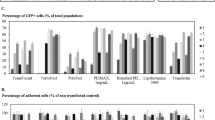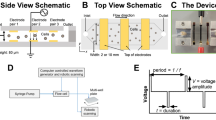Abstract
The need for γ-retroviral (gRV) vectors with a self-inactivating (SIN) design for clinical application has prompted a shift in methodology of vector manufacturing from the traditional use of stable producer lines to transient transfection-based techniques. Herein, we set out to define and optimize a scalable manufacturing process for the production of gRV vectors using transfection in a closed-system bioreactor in compliance with current good manufacturing practices (cGMP). The process was based on transient transfection of 293T cells on Fibra-Cel disks in the Wave Bioreactor. Cells were harvested from tissue culture flasks and transferred to the bioreactor containing Fibra-Cel in the presence of vector plasmid, packaging plasmids and calcium-phosphate in Dulbecco's modified Eagle's medium and 10% fetal bovine serum. Virus supernatant was harvested at 10–14 h intervals. Using optimized procedures, a total of five ecotropic cGMP-grade gRV vectors were produced (9 liters each) with titers up to 3.6 × 107 infectious units per milliliter on 3T3 cells. One GMP preparation of vector-like particles was also produced. These results describe an optimized process for the generation of SIN viral vectors by transfection using a disposable platform that allows for the generation of clinical-grade viral vectors without the need for cleaning validation in a cost-effective manner.
This is a preview of subscription content, access via your institution
Access options
Subscribe to this journal
Receive 12 print issues and online access
$259.00 per year
only $21.58 per issue
Buy this article
- Purchase on Springer Link
- Instant access to full article PDF
Prices may be subject to local taxes which are calculated during checkout






Similar content being viewed by others
References
Hacein-Bey-Abina S, Von Kalle C, Schmidt M, McCormack MP, Wulffraat N, Leboulch P et al. LMO2-associated clonal T cell proliferation in two patients after gene therapy for SCID-X1. Science 2003; 302: 415–419.
Williams DA, Baum C . Medicine. Gene therapy—new challenges ahead. Science 2003; 302: 400–401.
Howe SJ, Mansour MR, Schwarzwaelder K, Bartholomae C, Hubank M, Kempski H et al. Insertional mutagenesis combined with acquired somatic mutations causes leukemogenesis following gene therapy of SCID-X1 patients. J Clin Invest 2008; 118: 3143–3150.
Schambach A, Mueller D, Galla M, Verstegen MM, Wagemaker G, Loew R et al. Overcoming promoter competition in packaging cells improves production of self-inactivating retroviral vectors. Gene Therapy 2006; 13: 1524–1533.
Yu SF, von Ruden T, Kantoff PW, Garber C, Seiberg M, Ruther U et al. Self-inactivating retroviral vectors designed for transfer of whole genes into mammalian cells. Proc Natl Acad Sci USA 1986; 83: 3194–3198.
Dull T, Zufferey R, Kelly M, Mandel RJ, Nguyen M, Trono D et al. A third-generation lentivirus vector with a conditional packaging system. J Virol 1998; 72: 8463–8471.
Zufferey R, Dull T, Mandel RJ, Bukovsky A, Quiroz D, Naldini L et al. Self-inactivating lentivirus vector for safe and efficient in vivo gene delivery. J Virol 1998; 72: 9873–9880.
Thornhill SI, Schambach A, Howe SJ, Ulaganathan M, Grassman E, Williams D et al. Self-inactivating gammaretroviral vectors for gene therapy of X-linked severe combined immunodeficiency. Mol Ther 2008; 16: 590–598.
Zychlinski D, Schambach A, Modlich U, Maetzig T, Meyer J, Grassman E et al. Physiological promoters reduce the genotoxic risk of integrating gene vectors. Mol Ther 2008; 16: 718–725.
Montini E, Cesana D, Schmidt M, Sanvito F, Ponzoni M, Bartholomae C et al. Hematopoietic stem cell gene transfer in a tumor-prone mouse model uncovers low genotoxicity of lentiviral vector integration. Nat Biotechnol 2006; 24: 687–696.
Modlich U, Bohne J, Schmidt M, von Kalle C, Knoss S, Schambach A et al. Cell-culture assays reveal the importance of retroviral vector design for insertional genotoxicity. Blood 2006; 108: 2545–2553.
Loew R, Meyer Y, Kuehlcke K, Gama-Norton L, Wirth D, Hauser H et al. A new PG13-based packaging cell line for stable production of clinical-grade self-inactivating gamma-retroviral vectors using targeted integration. Gene Therapy 2010; 17: 272–280.
Throm RE, Ouma AA, Zhou S, Chandrasekaran A, Lockey T, Greene M et al. Efficient construction of producer cell lines for a SIN lentiviral vector for SCID-X1 gene therapy by concatemeric array transfection. Blood 2009; 113: 5104–5110.
Jordan M, Wurm F . Transfection of adherent and suspended cells by calcium phosphate. Methods 2004; 33: 136–143.
Hanenberg H, Xiao XL, Dilloo D, Hashino K, Kato I, Williams DA . Colocalization of retrovirus and target cells on specific fibronectin fragments increases genetic transduction of mammalian cells. Nat Med 1996; 2: 876–882.
Sastry L, Xu Y, Cooper R, Pollok K, Cornetta K . Evaluation of plasmid DNA removal from lentiviral vectors by benzonase treatment. Hum Gene Ther 2004; 15: 221–226.
Merten OW, Charrier S, Laroudie N, Fauchille S, Dugue C, Jenny C et al. Large-scale manufacture and characterization of a lentiviral vector produced for clinical ex vivo gene therapy application. Hum Gene Ther 2011; 22: 343–356.
Wright JF . Transient transfection methods for clinical adeno-associated viral vector production. Hum Gene Ther 2009; 20: 698–706.
Graham FL, van der Eb AJ . A new technique for the assay of infectivity of human adenovirus 5 DNA. Virology 1973; 52: 456–467.
Boussif O, Lezoualc’h F, Zanta MA, Mergny MD, Scherman D, Demeneix B et al. A versatile vector for gene and oligonucleotide transfer into cells in culture and in vivo: polyethylenimine. Proc Natl Acad Sci USA 1995; 92: 7297–7301.
Felgner PL, Gadek TR, Holm M, Roman R, Chan HW, Wenz M et al. Lipofection: a highly efficient, lipid-mediated DNA-transfection procedure. Proc Natl Acad Sci USA 1987; 84: 7413–7417.
Merten OW . State-of-the-art of the production of retroviral vectors. J Gene Med 2004; 6 (Suppl 1): S105–S124.
Merten OW, Cruz PE, Rochette C, Geny-Fiamma C, Bouquet C, Goncalves D et al. Comparison of different bioreactor systems for the production of high titer retroviral vectors. Biotechnol Prog 2001; 17: 326–335.
Peng Z . Current status of gendicine in China: recombinant human Ad-p53 agent for treatment of cancers. Hum Gene Ther 2005; 16: 1016–1027.
Wilson JM . Gendicine: the first commercial gene therapy product. Hum Gene Ther 2005; 16: 1014–1015.
Pierce LN, Shabram PW . Scalability of a disposable bioreactor from 25 L–500 L run in perfusion mode with a CHO-based cell line: a tech review. BioProcess J 2004; 3: 51–56.
Segura MM, Kamen A, Trudel P, Garnier A . A novel purification strategy for retrovirus gene therapy vectors using heparin affinity chromatography. Biotechnol Bioeng 2005; 90: 391–404.
Segura MM, Garnier A, Kamen A . Purification and characterization of retrovirus vector particles by rate zonal ultracentrifugation. J Virol Methods 2006; 133: 82–91.
Segura MM, Kamen A, Garnier A . Downstream processing of oncoretroviral and lentiviral gene therapy vectors. Biotechnol Adv 2006; 24: 321–337.
Schambach A, Swaney WS, van der Loo JCM . Design and production of retro- and lentiviral vectors for gene expression in hematopoietic cells. In: Baum C (ed). Methods in Molecular Biology, vol. 506, Humana Press: Totowa, NJ, 2009, pp 191–205.
Hildinger M, Abel KL, Ostertag W, Baum C . Design of 5′ untranslated sequences in retroviral vectors developed for medical use. J Virol 1999; 73: 4083–4089.
Kraunus J, Schaumann DH, Meyer J, Modlich U, Fehse B, Brandenburg G et al. Self-inactivating retroviral vectors with improved RNA processing. Gene Therapy 2004; 11: 1568–1578.
Schambach A, Galla M, Maetzig T, Loew R, Baum C . Improving transcriptional termination of self-inactivating gamma-retroviral and lentiviral vectors. Mol Ther 2007; 15: 1167–1173.
Schambach A, Bohne J, Chandra S, Will E, Margison GP, Williams DA et al. Equal potency of gammaretroviral and lentiviral SIN vectors for expression of O6-methylguanine-DNA methyltransferase in hematopoietic cells. Mol Ther 2006; 13: 391–400.
Baum C, Hegewisch-Becker S, Eckert HG, Stocking C, Ostertag W . Novel retroviral vectors for efficient expression of the multidrug resistance (mdr-1) gene in early hematopoietic cells. J Virol 1995; 69: 7541–7547.
Grez M, Akgun E, Hilberg F, Ostertag W . Embryonic stem cell virus, a recombinant murine retrovirus with expression in embryonic stem cells. Proc Natl Acad Sci USA 1990; 87: 9202–9206.
Reeves L, Smucker P, Cornetta K . Packaging cell line characteristics and optimizing retroviral vector titer: the National Gene Vector Laboratory experience. Hum Gene Ther 2000; 11: 2093–2103.
Geraerts M, Michiels M, Baekelandt V, Debyser Z, Gijsbers R . Upscaling of lentiviral vector production by tangential flow filtration. J Gene Med 2005; 7: 1299–1310.
Wikstrom K, Blomberg P, Islam KB . Clinical grade vector production: analysis of yield, stability, and storage of gmp-produced retroviral vectors for gene therapy. Biotechnol Prog 2004; 20: 1198–1203.
Higashikawa F, Chang L . Kinetic analyses of stability of simple and complex retroviral vectors. Virology 2001; 280: 124–131.
Persons DA, Baum C . Solving the problem of gamma-retroviral vectors containing long terminal repeats. Mol Ther 2011; 19: 229–231.
Herbst F, Ball CR, Zavidij O, Fessler S, Schmidt M, Veelken H et al. 10-Year stability of clinical-grade serum-free gamma-retroviral vector-containing medium. Gene Therapy 2011; 18: 210–212.
Nordling D, Kaiser A, Reeves L . Release testing of retroviral vectors and gene-modified cells. Methods Mol Biol 2009; 506: 265–279.
Food and Drug Administration. Guidance for human somatic cell therapy and gene therapy. Hum Gene Ther 2001; 12: 303–314.
Karolewski BA, Watson DJ, Parente MK, Wolfe JH . Comparison of transfection conditions for a lentivirus vector produced in large volumes. Hum Gene Ther 2003; 14: 1287–1296.
Naldini L, Blomer U, Gage FH, Trono D, Verma IM . Efficient transfer, integration, and sustained long-term expression of the transgene in adult rat brains injected with a lentiviral vector. Proc Natl Acad Sci USA 1996; 93: 11382–11388.
Feng Y, Liu Z, Cao H, Meng X, Qu Z, Xiong M et al. Construction of eukaryotic expression plasmid of human PRX3 and its expression in HEK-293FT cells. J Huazhong Univ Sci Technol Med Sci 2004; 24: 311–313, 321.
Cornetta K, Matheson L, Ballas C . Retroviral vector production in the National Gene Vector Laboratory at Indiana University. Gene Therapy 2005; 12 (Suppl 1): S28–S35.
Przybylowski M, Hakakha A, Stefanski J, Hodges J, Sadelain M, Riviere I . Production scale-up and validation of packaging cell clearance of clinical-grade retroviral vector stocks produced in cell factories. Gene Therapy 2006; 13: 95–100.
Wu SC, Huang GY, Liu JH . Production of retrovirus and adenovirus vectors for gene therapy: a comparative study using microcarrier and stationary cell culture. Biotechnol Prog 2002; 18: 617–622.
Schleef M, Schmidt T . Annimal-free production of ccc-supercoiled plasmids for research and clinical application. J Gene Med 2004; 6 (Suppl1): S45–S53.
Acknowledgements
We thank the following laboratories of the CCHMC Translational Core Laboratory (TCL): (i) Translational Trials Development and Support Laboratory (TTDSL) for titration of vectors using quantitative polymerase chain reaction, and (ii) the CCHMC Viral Vector Core for vector titration using flow cytometry. The Vector Production Facility in the TCL is supported by Institutional funds from the Cincinnati Children's Research Foundation. AS and CB thank the German Academic Exchange Service (DAAD), the European Union (FP7 program PERSIST) and the German Ministry for Research (BMBF project PIDNET.IFB-Tx) for their support. AJT acknowledges the Medical Research Council, The Wellcome Trust and Great Ormond Street Children's Charity for their support. Finally, we thank Dr Carolyn Lutzko for critically reviewing the manuscript.
Author information
Authors and Affiliations
Corresponding author
Ethics declarations
Competing interests
The authors declare no conflict of interest.
Rights and permissions
About this article
Cite this article
van der Loo, J., Swaney, W., Grassman, E. et al. Scale-up and manufacturing of clinical-grade self-inactivating γ-retroviral vectors by transient transfection. Gene Ther 19, 246–254 (2012). https://doi.org/10.1038/gt.2011.102
Received:
Revised:
Accepted:
Published:
Issue Date:
DOI: https://doi.org/10.1038/gt.2011.102
Keywords
This article is cited by
-
CAR T cells as micropharmacies against solid cancers: Combining effector T-cell mediated cell death with vascular targeting in a one-step engineering process
Cancer Gene Therapy (2023)
-
Production and purification of high-titer foamy virus vector for the treatment of leukocyte adhesion deficiency
Molecular Therapy - Methods & Clinical Development (2016)
-
Carbohydrates–chitosan composite carrier for Vero cell culture
Cytotechnology (2016)
-
Simple viral/minimal piggyBac hybrid vectors for stable production of self-inactivating gamma-retroviruses
BMC Research Notes (2015)
-
Manufacture of tumor- and virus-specific T lymphocytes for adoptive cell therapies
Cancer Gene Therapy (2015)



